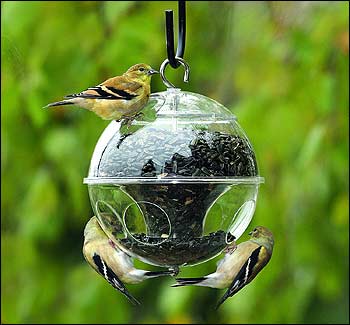Nesting Green Home & Garden Special Issue
Permaculturing South Lane Fern Hill Nursery offers large collection
How Do I Get Myself Some Birds? Birders, in their own backyards
Downsize to a Greener Lifestyle Kurt Jensen’s little houses for better living
Seed, Save, Share A revolutionary act against commercial seed industry
Green and Cheap BRING offers remodel options that go easy on the budget
How Do I Get Myself Some Birds?
Birders, in their own backyards
by Kate Loftesness
The indecisive and rapidly changing weather of spring has reached Eugene and blooming flowers and singing birds are soon to follow. To maximize your enjoyment of spring, local bird experts recommend easy ways to attract birds to your backyard.
 |
“The simplest thing is to just put out a feeder,” says Dan Gleason, a UO professor and the author of books and articles about birds. The choice of birdseed can also affect your bird-attracting success. Gleason recommends black oil sunflower seeds, but mixed feed will also work and attract different kinds of birds who don’t eat the sunflower seeds.
Dick Lamster, past president of the Lane County Audubon Society, encourages people to make smart bird-feeding decisions. “If you’re going to do it, you’ve got to do it right,” he says.
It is important not to place bird feeders anywhere that might place birds at risk, like close to the ground or near bushes that might conceal predators. This means if you have a cat or neighborhood cats come into your backyard, you shouldn’t try to attract birds. “Why bother feeding them if you’re going to kill them? Cats eat birds. It’s not their fault, but it’s what they do,” Lamster says.
Large plate-glass windows pose another danger to birds. Birds only see the reflection in the glass or a large dark space they think they can fly through, says bird expert Rick Ahrens. “Put ribbons, pieces of tape, on the outside of the window so they’ll flutter in the breeze so the movement will tell the birds ‘Don’t come here,’” Lamster says.
Lamster and Ahrens also recommend water as a means of attracting birds to your backyard so they can drink or clean their feathers. “It can be as simple as an old-fashioned bird bath,” Lamster said, “or more elaborate like a fountain or a waterfall.” He recommends using shallow containers so that small birds can actually stand in the water, and he also recommends changing standing water every five days to prevent mosquitoes.
For serious bird-seekers, Ahrens suggests bird-scaping your yard with the help of local nurseries. “Consider planting native berries, Oregon grape, things like that that birds will feed on but aren’t invasive,” adds Gleason.
Contrary to popular belief, the experts say, birdhouses can often cause more harm than good for birds. They will attract only birds that like to nest in boxes, including English sparrows and starlings, two invasive species who can take over a habitat and harm native species that were already there.
“Birdhouses aren’t as simple as they sound,” Lamster says. You need to have the right size house, right size hole, right place, and right distance from the ground; otherwise, predators can get inside and kill the birds. Also, they need to be maintained and cleaned out every fall.
“In most cities, including Eugene, birdhouses are just not worth the effort,” he says. Instead, he recommends people focus on bird feeders. Often, he says, well-intentioned people want to make birdhouses as crafts, but bird feeders can be homemade just as easily.
Other common mistakes Lamster warns against are using red dye or anything other than white sugar to make nectar for hummingbirds and using any kind of pesticide in your yard.
Migratory birds will soon be returning to Eugene, although some have never left. One kind of hummingbird remains in Eugene all year long, some of the migratory birds are already back and more species will be returning through May.
Why should you consider attracting birds to your backyard? “Just simply for your own pleasure,” Gleason says.
“They’re beautiful! Their songs are beautiful; they’re beautiful and they’re funny critters to watch,” Lamster says. He also stresses the multi-generational and cross-cultural educational value of bird watching.
Lamster, who has 45 birdhouses on his own property, acknowledges that cost may be a deterrent to some, but it doesn’t dampen his enthusiasm. “All this stuff’s a little spendy, but I like to tell people that bird-feeding is a hobby, and all hobbies cost money!” he says. “You can also shop around, buy bird seed in large quantities, or wait for it to go on sale.”
All the bird experts agree that going about attracting birds the right way is the most important thing. If you’re not sure about anything bird-related, Eugene has plenty of expert resources. For instance, Lamster answers phones for the Lane County Audubon Society at 541-485-BIRD (541-485-2473). He says, “Know what you’re doing, or call me!”
Our thanks to Mount Pisgah Arboretum’s Katura Reynolds for all of her help with this story. She also says there are great upcoming bird walks at Pisgah; for more info, follow @MtPisgahArb on Twitter or go to http://wkly.ws/eq for a list of walks at Pisgah. Lane County Audubon Society bird walks can be found at http://wkly.ws/er.